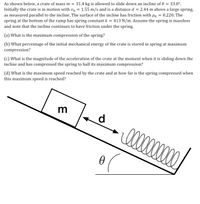Question
I only need help with part a please.

Transcribed Image Text:As shown below, a crate of mass \( m = 31.4 \) kg is allowed to slide down an incline of \( \theta = 33.0^\circ \).
Initially, the crate is in motion with \( v_0 = 1.55 \) m/s and is a distance \( d = 2.44 \) m above a large spring, as measured parallel to the incline. The surface of the incline has friction with \( \mu_k = 0.220 \). The spring at the bottom of the ramp has spring constant \( k = 413 \) N/m. Assume the spring is massless and note that the incline continues to have friction under the spring.
(a) What is the maximum compression of the spring?
(b) What percentage of the initial mechanical energy of the crate is stored in the spring at maximum compression?
(c) What is the magnitude of the acceleration of the crate at the moment when it is sliding down the incline and has compressed the spring to half its maximum compression?
(d) What is the maximum speed reached by the crate and at how far is the spring compressed when this maximum speed is reached?
**Diagram Explanation:**
- The image shows an inclined plane with an angle \( \theta \).
- A crate, labeled with mass \( m \), is positioned on the incline.
- There is a spring at the bottom of the incline.
- The crate’s initial distance from the spring is marked as \( d \).
- An arrow indicates the direction of motion down the incline towards the spring.
Expert Solution
This question has been solved!
Explore an expertly crafted, step-by-step solution for a thorough understanding of key concepts.
This is a popular solution
Trending nowThis is a popular solution!
Step by stepSolved in 2 steps with 7 images

Knowledge Booster
Similar questions
- Part C At 7 s? Express your answer with the appropriate units. ► View Available Hint(s) (Fnet).x = HÅ Value Ć Units ?arrow_forwardCan someone please help me .with this I’m very confusedarrow_forwardI need help with part B please. Thank you! In the Challenger Deep of the Marianas Trench, the depth of seawater is 10.9 km and the pressure is 1.16×10^8 Pa, (about 1150 atmospheres). (A) If a cubic meter of water is taken to this depth from the surface (where the normal atmospheric pressure is about 1.0×10^5 Pa), what is the change in its volume? Assume that the bulk modulus for seawater is the same as for freshwater 2.2×10^9 Pa. Answer: -5.3E-2 m^3 (B) At the surface, seawater has a density of 1.03×10^3 kg/m^3. What is the density of seawater at the depth of the Challenger Deep? Express your answer in kilograms per cubic meter.arrow_forward
- Problem 2: Assume negligible friction between the crate and the surface. In both situations, a man exerts a 300 N force on a crate that has a mass of 50 kg. The angle in both scenarios is 30 degrees. 15 F A. Draw two free-body diagrams with the crate as the object of interest-one for each scenario. Label the individual forces that act on the crate clearly. B. Separately for each situation, state whether the normal force is equal to, greater than or less that the weight force? Explain your reasoning.arrow_forwardHW Help: Just part C, Thank you!arrow_forwardI wonder if you can't assist me with this problem. I see that we're being asked to find V_o, but in order to solve, we need to calculate the time and the acceleration. We have the means to solve for acceleration using the second set of data values, then plug that value in to find time. But i'm a bit lost after that. Attached are photts of the question and my work.arrow_forward
- I tried doing this question and couldn't figure out what I was doing wrong can you help me find out what I am missing in my calculations for this problem?arrow_forwardMust solve the question completely. Don't solve partially. Skip it pls if u don't want to solve it completely. You must solve the complete question all 6 parts. Otherwise you can skip and let others solve it. But don't solve it partially one or three questions. If you do it, I will dislike for sure.arrow_forwardStuck need help! The class I'm taking is physics for scientists and engineers! Problem is attached. please view attachment before answering. Really struggling with this concept. Any help will be greatly appreciated! Please detail explain so I can fully understand how to solve. Thank you so much.arrow_forward
arrow_back_ios
SEE MORE QUESTIONS
arrow_forward_ios